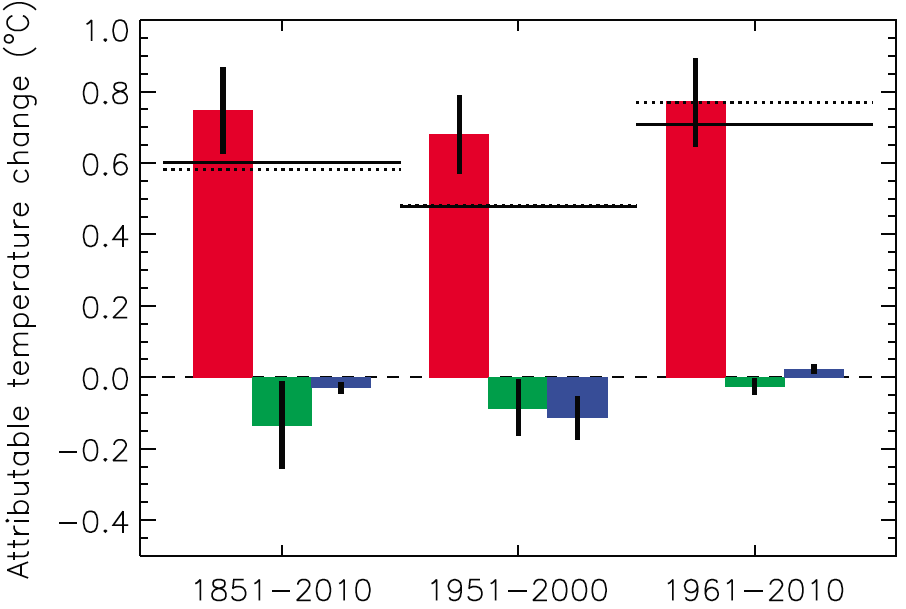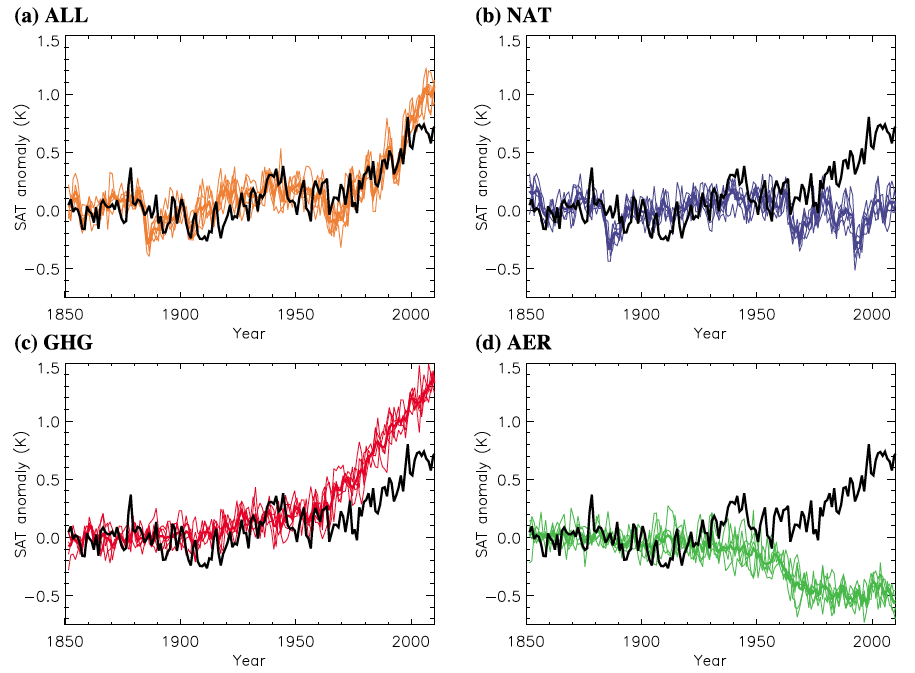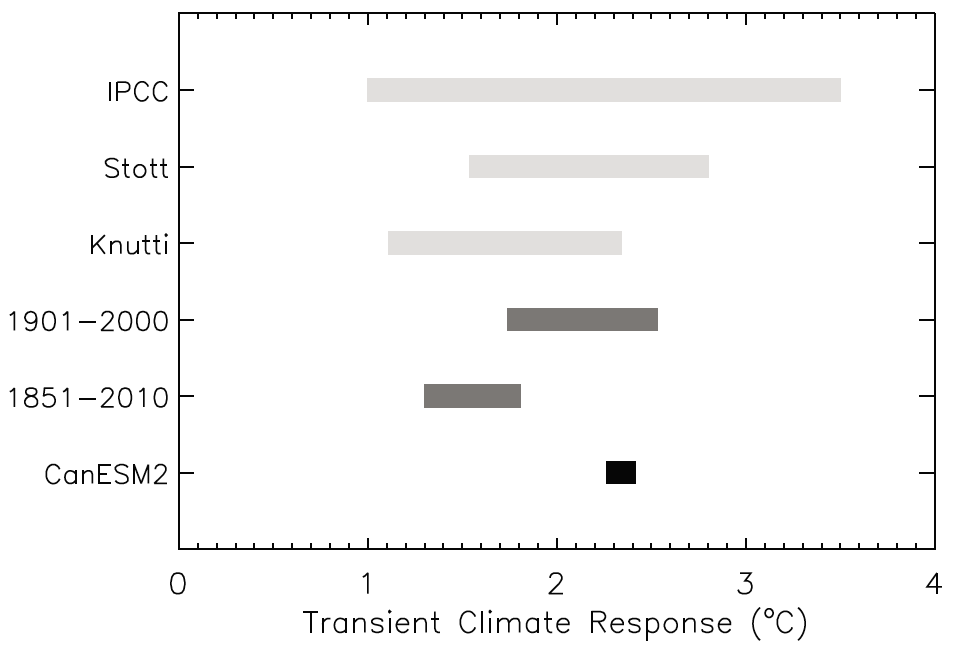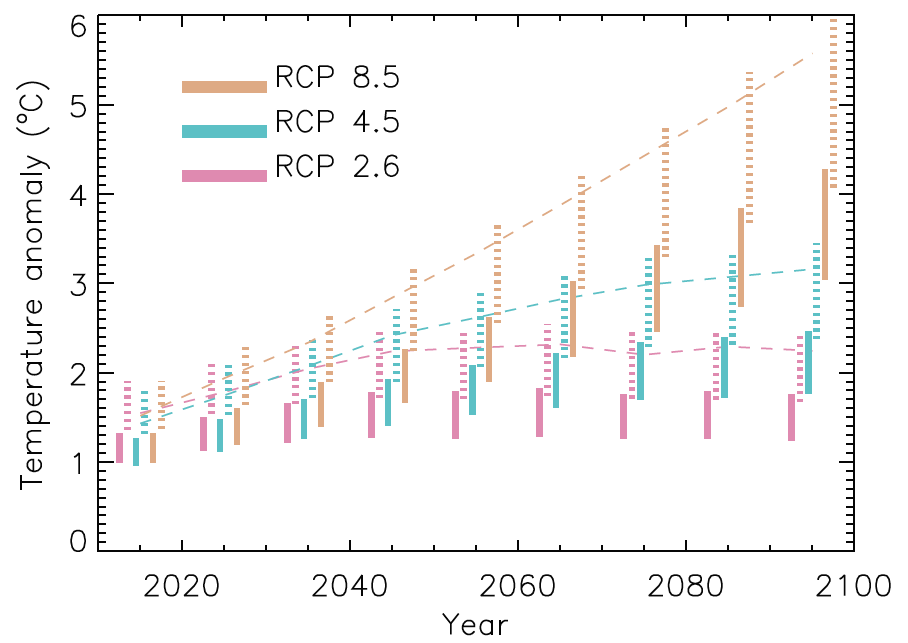Gillett et al. Estimate Human and Natural Global Warming
Posted on 14 January 2012 by dana1981
In another new global warming attribution study (we will soon do an overview of the results of this and similar studies), Gillett et al. (2012) perform a number of interesting analyses. First, they estimate the contributions of various different components (both human-caused and natural) to the observed global warming. They also use their results to estimate the transient climate response (TCR), which refers to the global mean temperature change that is realised at the time of CO2 doubling in a scenario in which CO2 concentrations increase by 1% per year. In short, the TCR is an estimate of how much global surface temperatures will warm immediately, without needing to consider factors like the thermal inertia of the oceans. Gillett et al. then use their TCR estimate to project how much the planet will warm in the future based on several different emissions scenarios.
On the attribution question, the results of Gillett et al. are consistent with the many other attribution studies we've looked at (i.e. Lean and Rind 2008, Huber and Knutti 2011, and Foster and Rahmstorf 2011) - namely that humans have been the dominant cause of the global warming over the past 25-150 years (Figure 1).
Figure 1: Gillett et al. attributable temperature changes due to greenhouse gases (red), other anthropogenic effects (green), and natural effects (blue) over each of the periods indicated in °C, based on the standard regression over the 1851–2010 period, with their associated uncertainties (vertical black lines). Horizontal dashed black lines indicate the sum of the trends attributable to each forcing, and horizontal solid lines indicate observed trends.
However, the conclusions of Gillett et al. with respect to the transient climate response are somewhat more unexpected, as we will see below.
Methods
Gillett et al. use new historical simulations and Representative Concentration Pathway (RCP) scenario simulations using the second generation Canadian Earth System Model (CanESM2) firstly to derive scaling factors on the greenhouse gas and aerosol forcing responses which give the best fit to observations over the historical period, and then to derive observationally-constrained projections of 21st-century temperature change. They use a regression-based method to scale the model-projected warming up or down according to whether it under- or over-predicts the response to anthropogenic forcings over the historical period.
"We use 1280 years of control simulation, with constant preindustrial forcings including constant specified CO2, and a five-member ensemble of historical simulations from 1850–2005 including prescribed historical greenhouse gas concentrations, SO2 and other aerosol-precursor emissions, land use changes, solar irradiance changes, tropospheric and stratospheric ozone changes, and volcanic aerosol (ALL), following the recommended CMIP5 specifications. We also use five-member ensembles of simulations with greenhouse gas changes only (GHG), volcanic and solar irradiance changes only (NAT), and aerosol changes only (AER) over the period 1850–2010."
For their future climate projections, Gillett et al. use five-member ensembles of scenario simulations from 2006–2100 with RCP 2.6, RCP 4.5, and RCP 8.5 emissions scenarios. The numbers in the emissions scenarios refer to the radiative forcing in 2100 in Watts per square meter (W/m2) relative to pre-industrial levels, from all human effects. For example, the RCP 4.5 scenario projects a 4.5 W/m2 radiative forcing in 2100 (for reference, a doubling of atmospheric CO2 alone corresponds to approximately 3.7 W/m2).
Attribution Results
As shown in Figure 1, in every timeframe examined, greenhouse gases account for over 100% of the observed global warming. When combined with the other human effects, the net human influence is responsible for approximately 102% of the observed warming from 1851 to 2010, and approximately 113% over the 50-year periods from 1951 to 2000 and 1961 to 2010 (averaged together). The natural contributions are -4.8% and -6.5%, respectively, in both cases having a net cooling effect. The model simulations of the various effects are shown in Figure 2.
Figure 2: Gillett et al. time series of global mean near-surface air temperature anomalies in observations and simulations of CanESM2. Black lines show observed global mean annual mean temperature from HadCRUT3, and thin coloured lines show global mean temperature from five-member ensembles of CanESM2 forced with (a) anthropogenic and natural forcings (ALL), (b) natural forcings only (NAT), (c) greenhouse gases only (GHG), and (d) aerosols only (AER). All anomalies are calculated relative to the period 1851–1900, and ensemble means are shown by thick coloured lines.
One odd result of note, as can be seen in the solid horizontal black lines in Figure 1, is that Gillett et al. estimate greater net warming from 1851 to 2010 (approximately 0.6°C) than from 1961 to 2010 (approximately 0.7°C). Fitting a linear trend to the HadCRUT3 data from 1851 to 2010 yields a net warming of approximately 0.7°C (vs. approximately 0.68°C from 1961 to 2010). Dr. Gillett offered an explanation for this apparent discrepancy (personal communication) involving the following factors:
-
Their temperature trends are based on linear least-squares trends fitted to the observations, as opposed to differences between the beginning and ends of each period in question.
-
Gillett et al. use decadal averages of the temperature data.
-
The trends shown in Figure 1 above are based on a projection on spherical harmonics (instead of using the simple global average temperature, this process regresses simultaneously against each grid cell, thus preserving the correct spatial distribution of the field), and a limited number of empirical orthagonal functions, which could impact the results somewhat as well.
The result still remains counter-intuitive, and most other similar attribution studies (like those referenced above) generally estimate between 0.65 and 0.85°C warming over the past 100-150 years. The relatively low warming estimate from 1851 to 2010 in the Gillett study appears to influence their TCR results.
Transient Climate Response
Gillett et al. derive the TCR by using a regression-based method to scale the model’s projected warming up or down according to whether it under- or over-predicts the response to anthropogenic forcings over the historical period.
Given that Gillett et al. attribute essentially all of the observed warming to human influences, you would expect their study to yield a relatively high TCR. After all, the TCR is associated with the temperature change in response to increasing CO2, and Gillett et al. attribute essentially the entire observed global surface warming to the greenhouse gas increase.
However, as discussed above, Gillett et al. also attribute a relatively small amount of warming (~0.6°C) to that greenhouse gas increase. On the other hand, they attribute a relatively large surface warming (~0.7°C) to the greenhouse gas increase from 1961 to 2010. This results in different estimates for the TCR for different timeframes. Most notably, constraining the model with data from a timeframe excluding the earliest years (1901-2000) results in a higher TCR than using the 1851-2010 data (Figure 3).
Figure 3: TCR directly simulated by CanESM2 (black), constrained by observations using the 1851–2010 and 1901–2000 regressions (dark gray), and derived from observational constraints by Stott et al. [2006] (Stott), Knutti and Tomassini [2008] (Knutti), and Hegerl et al. [2007] (IPCC) (light gray).
As Figure 3 shows, Gillett et al. find quite different TCRs using 1851-2010 and 1901-2000 timeframes. The former is towards the lower end of the IPCC range, whereas the latter is close to its central values. Gillett et al. comment on the difference (emphasis added):
"By contrast, when regression coefficients calculated over the shorter 1901–2000 period following [Stott et al., 2006] are used to scale projections, projected warming is larger and consistent with that directly simulated, illustrating the sensitivity of the results to the regression period used."
These differing TCRs also result in quite different projections of future warming (Figure 4).
Figure 4: Gillett et al. temperature projections. Dashed lines show directly simulated global mean decadal mean temperature anomalies for each decade of the 21st century relative to the 1851–1860 mean for each RCP. Coloured bars show uncertainty ranges on observationally-constrained projections, derived by scaling projected GHG- and OTH-induced temperature changes using the 1851–2010 (solid) and 1901–2000 (dotted) GHG and OTH regression coefficients. All uncertainty ranges are 5–95%.
The dotted bars (which represent the model run when constrained by the 1901-2000 data) match the simulated projected temperatures (dashed lines) much more closely than the solid bars (based on the 1851-2010 regression). Note that this represents a transient response - Gillett et al. did not evaluate equilibrium climate sensitivity. It's also possible that a lower TCR would simply indicate a longer equilibrium response time.
Caveats and Conclusions
Gillett et al. warn against over-interpreting their results, which are based on just one model, and which are sensitive to the regression period used:
"We therefore recommend caution in interpreting the scaled projections derived from this single model, since our uncertainty estimates account only for possible errors in the magnitude of the simulated responses to the forcings, and not for possible errors in the observations, in the forcings, or in the spatio-temporal patterns of response to those forcings. We suggest that a similar analysis be carried out using multiple models once the necessary simulations are available, which will allow the effects of model uncertainty to be better accounted for."
This of course has not stopped the usual suspects from doing just that - over-interpreting and distorting the results of Gillett et al. However, this behavior will be the subject of another forthcoming blog post.
Given that there is greater uncertainty associated with the HadCRUT data prior to 1900 due to fewer stations and sparser global coverage, and that the TCR constrained by 1901-2000 data better matches the IPCC central TCR estimates, their higher TCR (approximately 1.7 to 2.5°C) seems more likely to be correct. Regardless, as with many attribution studies before them, Gillett et al. attribute the vast majority of the recent global warming to human activity.
Stay tuned for a summary and comparison of recent global warming attribution studies, including Gillett et al., and a blog post on the distortion of their results by certain fake skeptics.































 Arguments
Arguments


































[DB] Please refresh yourself with the Comments Policy.
Accusations of deception snipped.
[DB] Everyone: No accusations of deception. Any accusations of deception, fraud, dishonesty or corruption will be deleted.
This applies to all parties.
Now, Skeptical Science has posted another summary of another study on this matter — human versus natural causes of global warming. This summary is on a new paper just published in 2012.